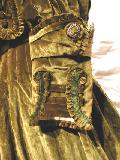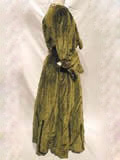This green silk velvet bodice and skirt was made in Baltimore, Maryland, by Joel Gutman and Co., as noted in the labels found both at the neck edge and in the skirt. It is c. 1902. The majority of the dress was stitched together by machine, but all trim work and finish work were stitched by hand.
Figure 1: Label |
 |
Bodice
The bodice of the dress is constructed in two parts: an under blouse lining attached to the belt, and a bolero. The two pieces are joined at the neck edge, 1 inch in from center front, and at the armseye. The bodice is constructed to give the effect of a bolero with a collared shirt underneath, finished by a belt. While many dresses of this period have high collars, this one has a low, flat to the neck collar. The construction for the bodice would best be described from the inside out, beginning with the under blouse.
The under blouse is made from cotton satin flat-lined with white cotton batiste by machine and then seamed at the side seams and center back by machine. Green China silk is used to face upwards from the belt 2 3/4". This is machine stitched onto the blouse with off-white thread. There is a four-layer lace unit that is machine stitched on top of the China silk at the center front edge. The piece consists of a stabilizer, cream satin, cotton bobbin lace, and manufactured trim stitched down on top.
The lace piece is then machine stitched on top of the under blouse 5" from the center front edge. The blouse body is hand finished at the neck, center front, armhole, shoulder seam, and waistband. It is disintegrating at the armholes from perspiration. This under blouse becomes the lining for the completed jacket.
Figure 2: Side Front |
Figure 3: Side Back |
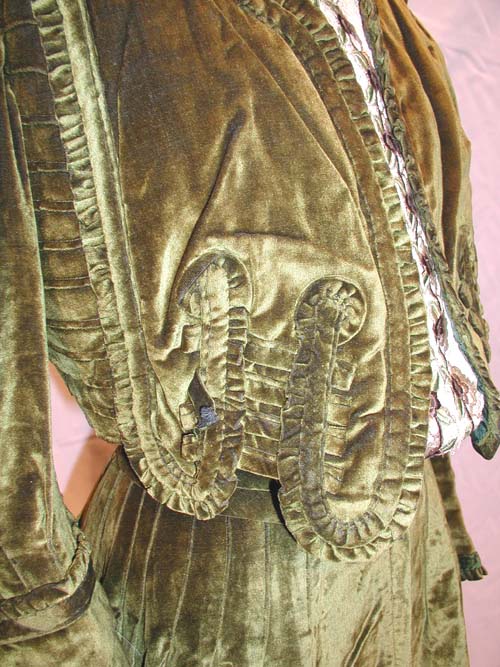 |
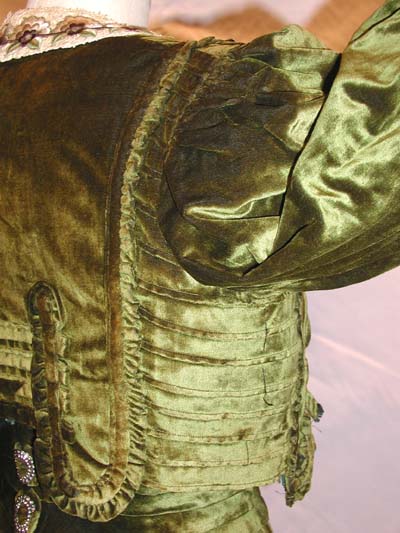 |
Closures: Ten hooks and eyes are used to close the bodice on the center front. There are six steel hooks on the bodice and four hooks on the best. The bottom hook and eye is brass. The hooks are sewn in between the layers of lace trim and satin lining to hide as much of the metal as possible.
Figure 4: Lining |
Figure 5: Closure |
 |
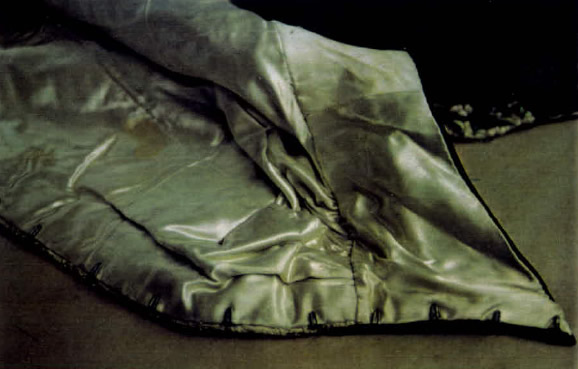 |
Belt: The belt is constructed of four separate bias strips of velvet overlapped by hand. The belt is shaped so that it drops to a point both at center front and at center back, these points supported by bones. The belt inner structure is a dark brown canvas that is machine seamed at least once 1/2" forward of the side front lining seam. Four inches from the side seam of the lining, the bodice is cartridge pleated to the waistband, stopping 3/4" from the front edge of the bodice. All layers of the bodice are pleated at the same time and the original pleating stitches are present.
Figure 6: Belt Detail |
Figure 7: Belt |
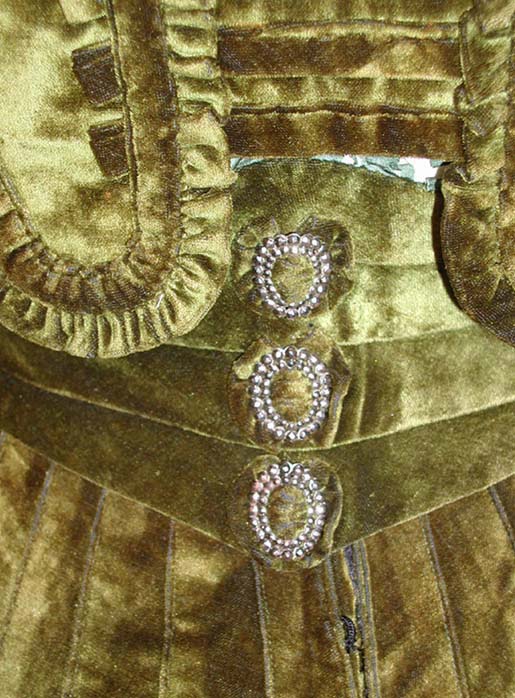 |
 |
The lining is constructed of six pieces with a side front, side back and center back seams all sewn by machine. The lining is then stitched down to the belt by hand. This covers all raw edges and finishes the inside of the bodice. At the center back of the belt, three (3) metal decorations are applied to the waistband. They seem to be silver colored rings with a bias tube run through the open center and gathered around the edges (see pattern and detail images). These were stitched onto the waistband before the lining was completed.
Bolero
The bolero is made from a bottle green silk velvet. It is constructed of three major parts: a front panel that stops one inch (1") short of center front; a tucked side panel that creates the armhole, and aback piece that is cut on the fold of the fabric. The back of the bolero is flat-lined by hand to a brown open weave cotton canvas. The side of the bolero has 1/4" tucks every 7/8". There is no side seam, but the original thread mark noting the true side is still in the garment. The side piece is seamed at the shoulder and to the front and back, by machine. The front and back seams are hidden beneath the applied trim. The side and back pieces are flat lined with cotton batiste. The side is also flat lined with the brown canvas. A forest green China silk lining is hand sewn in, covering the inside of the bolero 2" up at the center back and 3" on the sides. On the side pieces, forward of the side seam, a layer of cotton batting covered with a polished dark green cotton is hand stitched onto the bolero to add extra padding where the corset line would be. A reinforcement layer of black crinoline can be found beneath the lining at the neck edge. It is seamed at the shoulder. The lining on the front is completed with more green silk lining hand stitched up to 1/2" beyond the lower edge of the collar.
Applied Trim
The applied trim is a bias strip that has been pressed and hand-stitched into a 1/2" rouleau tube. The seam line is left visible so that it appears to be two rows of trim, one 3/8" wide and the other 1/8” wide. Another strip of bias is folded in half and gathered into 1/2"” wide bias ruffle is then applied underneath the 3/8" side of the tube. The gathered ruffle finishes the top edge of the trim in a circular fashion instead of being squared off. Four bars of the rouleau are catching the motifs together at center back, and on each side of the lower front edge.
Lace Collar and Front
The lace and embroidery are stitched together by hand onto cream satin with a layer of crinoline stiffening the lace. The lace appears to be machine-made cotton lace, with a floral pattern on a fairly coarse, open, 1/4" square background. The embroidery is machine stitched down the lining a full 5" from the center front edge, even though only 1 1/2" is seen at the front. It extends from the shoulder seam to the waistband. Again only about 3" can be seen up from the waistband. The collar is constructed in the same manner as the front lace piece and is completely hand-stitched to the bolero neckline.
Figure 8: Collar and Trim |
Figure 9: Applied Trim |
 |
 |
Sleeves
The sleeve is made from three parts: the main sleeve, a cuff, and a lower sleeve. The main sleeve is set into the armseye with the underarm seam 1 1/2" forward of the side seam mark line. 1 1/2" to the front of the seam, the velvet is cartridge pleated into the armseye, stopping 2 3/4" past the shoulder seam. The sleeve is not flat lined, but a bias piece of black crinoline acts as a head in the cartridge pleating. The total length of the underarm seam is 11". The bottom of the sleeve is tucked in with 3" long tucks to create a 13" width at the bottom of the sleeve. There are a total of 14 tucks, starting 1 1/4" from the underarm seam.
The sleeve lining is one piece from the armseye to the hem of the lower sleeve. It is hand stitched at the hem and to the under bodice at the armseye. A 2" satin band is basted into the sleeve, finishing the bottom of the sleeve and providing a lining for the section of the cuff that is exposed. A satin band is basted into the cuff with a 1/4" piped edge to finish raw edges.
The cuff is constructed from two pieces. A triangle-shaped insert of lace similar to the front of the bodice shows from underneath the velvet section of the cuff. The cuff is lined with cream satin, stitched onto the velvet by hand, after the velvet was applied. The edge of the velvet section of the cuff should be in line with the trim on the lower arm. One of the same metal buckles that appears on the belt is sewn into the cuff.
The lower sleeve is a separate piece that is under the pleated sleeve. It is attached to the upper sleeve by means of hand-stitching underneath the section of the sleeve covered by the cuff. This piece has applied trim similar to the bolero.
Figure 10: Sleeve |
Figure 11: Cuff |
 |
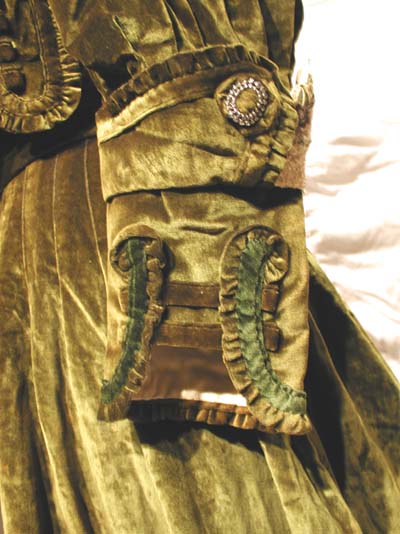 |
Skirt
The skirt has four panels with small triangles pieced into the side front and center back seams to add extra width to the fabric. The original fabric was probably only 32" wide and didn’t allow for as much width as desired. The waist is pleated with top stitching 5" along a waist of 26". The original waistband is missing from the garment. The trim on the skirt is similar to that of the bolero. It is wider, about 5/8"” in width, and there is no gathered section to the trim. All of the trim is stitched on by hand. The skirt appears to have been taken up from its original line. The placket on the skirt is closed with three covered eyes and metal hooks. There is also a hook at the waist where the waistband should be. The hem of the dress appears to have been raised at some point. It was machine stitched down, but the trim over the hem was not stitched through. The original hem line is still visible.
Figure 12: Skirt Edge Interior (above)
|
Figure 13: Skirt Trim |
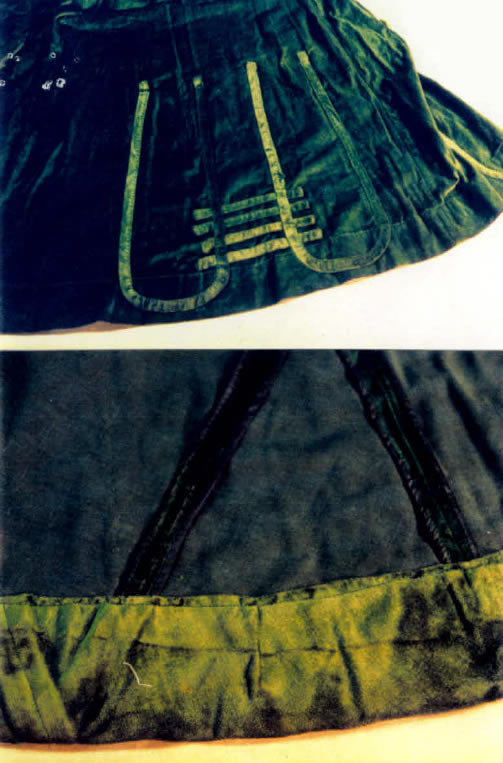 |
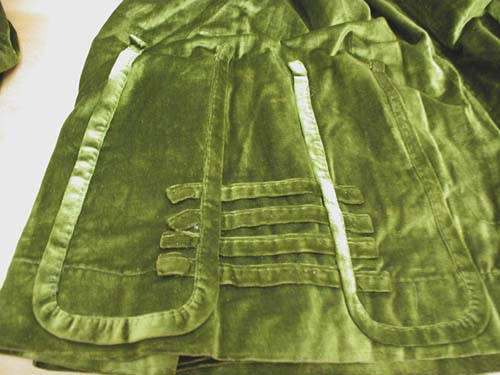 |
Damage
The garment is in excellent condition. The only visible alterations on the garment are on the skirt which seems to have been shortened from the original length, being stitched by machine through all layers for the new hem. The original waistband is missing as well.
© Kerri Martinsen, 1999


